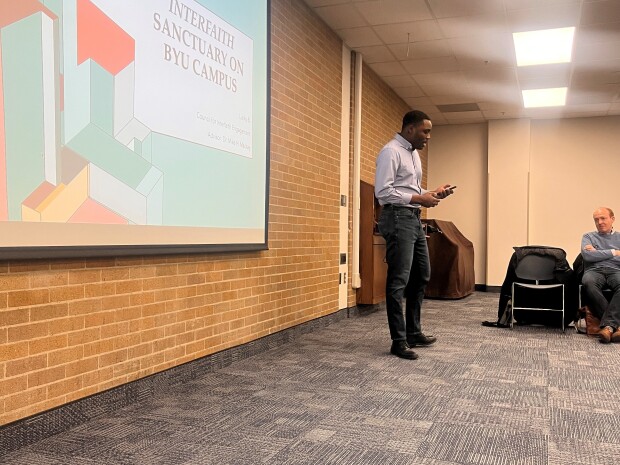BYU Council for Interfaith Engagement student fellow Lucky Bahati is dedicating his fellowship project to creating an interfaith sanctuary on campus.
The sanctuary would not be a specific house of worship, Bahati said, but rather a sacred space that is focused on belonging for all students and allowing them an experience with the divine, encouraging prayer, contemplation, peace and hope.
There are at least 32 religious denominations on campus, Bahati said, and an interfaith sanctuary would help students of other faiths feel that they belong on campus and are not forgotten.
This Bahati’s second year on the council, and his own experience as a non-Latter-day Saint student on BYU campus is what pushed him to want to get involved in the interfaith council.
The project has been proposed to the council. Pending approval of some kind of trial run would be the next step, followed by the designation of a place for the project, design, inventory and the opening of the sanctuary, Bahati said.
“The reality is that interfaith work in an interfaith environment, interfaith cooperation, interfaith acceptance, all of these things already exist on campus,” said McKay Bowman, president of the Interfaith Student Association. “But … there’s something special, important and valuable about having a physical representation of that fact.”
Bahati, who is a non-denominational Christian, said he visited Georgetown University last summer and saw their version of an interfaith sanctuary. He said this experience inspired him to want to explore a similar project on BYU campus.
Mike MacKay, a religion professor who serves as head of the Interfaith Student Association and the faculty advisor for Bahati’s project, said the space could help the non-Latter-day Saint population feel like they belong and have a place on campus.

Bahati presented his project idea at an IFSA activity, where Elliot Wise, faculty fellow on the Council for Interfaith Engagement, suggested the BYU Museum of Art as a place to test an interfaith space, Bahati said. If approved, a MOA trial run could involve works of art from other religions and give students a chance to interact with and engage with a space that has sacred elements from another faith, and see how the space is received, MacKay said.
Bowman said that the final interfaith space will need to balance visibility, to show the importance of representation and the desire to value the contributions of those of other faiths, as well as being somewhere where people can take a break and worship, and feel that it is sacred and set apart.
Bahati said he does not know what the final space will end up looking like but hopes that his project can promote unity on campus.
“There is no (better) way to love your neighbor than to know them,” Bahati said, and this sanctuary could create curiosity and help students want to know more about other religions and learn more about them. It would also give students in world religion classes an opportunity to have an immersive learning experience, Bahati said.
The interfaith space would have a positive effect on Latter-day Saint members of the BYU community, MacKay said. “I think it’ll have the positive influence to realize that other people are also doing good in the world and the spirit can be found within the hearts of any person.”
To help support the project, students can tell other members of the BYU community about it, Bahati said, and get involved with interfaith efforts on campus or join the Interfaith Student Association.




